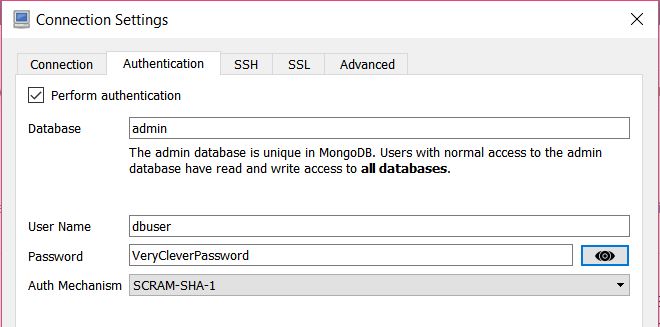

- Robo 3t authentication how to#
- Robo 3t authentication install#
- Robo 3t authentication code#
- Robo 3t authentication free#
The profile route gives access to the user data through a GET request and allows a user to set their username through a PUT request. The response depends on the game’s status as lost, won, or ongoing. The contains the incoming guess of the player which is added to the lettersGuessed property of the user document and saved back to the database. connect ( `mongodb://localhost:27017/hangman` ).
Robo 3t authentication install#
You can install and run MongoDB using Homebrew like so:Ĭonst express = require ( ' express ' ) const cors = require ( ' cors ' ) const bodyParser = require ( ' body-parser ' ) const mongoose = require ( ' mongoose ' ) const bearerToken = require ( ' express-bearer-token ' ) const oktaAuth = require ( '. The MongoDB documentation pages provide excellent install instructions specific to your operating system.
Robo 3t authentication free#
A free Okta developer account for OIDC authenticationīefore you start, install the MongoDB database from the servers or via Homebrew.For the back-end, I will be using a Node-based REST server implemented with Express. The front-end of the game will be implemented using the Angular framework.

Robo 3t authentication how to#
In this tutorial, I will show you how to use the MongoDB database to implement a simple Hangman game. For a social media app that expects millions of users from all over the world, a NoSQL database should be used. For a banking app where consistency is adamant, SQL databases would be the right choice. Ultimately, SQL and NoSQL databases have different use cases. You can even split your data into shards and run each shard on a separate server to distribute around the world and improve access times for users in different locations. This design makes NoSQL databases almost as flexible and provides huge scalability gains. NoSQL databases like MongoDB store data in documents that can be retrieved as JSON objects, rather than tables. The downside? SQL databases are relatively rigid and they don’t scale well with large datasets. They also allow you to define complex relationships between different parts of your data and provide tools for ensuring that the data is consistent at all times. SQL databases are a good choice if you have well-defined data that will not change much over time. But what is a NoSQL database, and why would you want to use one in the first place? To answer this question, let’s step back and look at SQL databases and where they shine.
Robo 3t authentication code#
Without having a user relationship with the database we cannot authenticate the user.Ī code is provided to create a user, by passing the password and username we can authenticate any user in the return response of Boolean.MongoDB is often the first suggestion when it comes time to select a NoSQL database. In the first part, we discussed the user and in the second part, we discussed the authentication of the user. We discussed two major things in this tutorial. If any user has no association with the database collection which is called then the access automatically gets denied. It will allow us to validate and verify the information of the user who is connected with the current instance of MongoDB. On the Authentication tab, click the checkbox Perform Authentication. Now we are ready to click on the Authentication tab up top. For the Type, we are going to select Replica Set.

Click the create button at the top of this window to create a new connection. another instance of docker was running and blocking the connections. Open Robo 3T and click the file option, then click connect. MongoDB also supports “LDAP” authentication.Īuthentication is the most critical point of view according to the security of MongoDB. Solved-mongodb runing on docker Failed to auth on robo 3t-mongodb. The default authentication mechanism is “SCRAM”. MongoDB provides multiple ways to identify the client and validate its information. If the user gets authenticated, the resultant answer will be the one and if it is not authenticated then the answer will be zero. This method requires two parameters, in the first parameter we have to declare the username and in the second parameter, we have to declare the password. MongoDB provides a method by which we can authenticate any user to an instance of the database. The readWrite role in the product database.The admin database clusterAdmin and readAnyDatabase roles.The operation gives the following roles to AdminSTH: writeConcern – It is the level of permission which is used to write something on physical memory.user – It is the type of document and contains authentication regarding the user information which you want to insert within the system.After creating the user we can authenticate that user according to the instance of the database.įrom the following code, we can create a user for the admin database. Before starting authentication, we need to create a user who has all access to the current database.


 0 kommentar(er)
0 kommentar(er)
